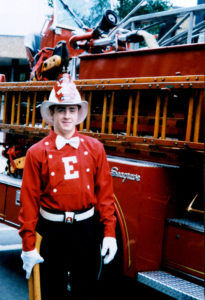THE RED BANDANA

One Sunday morning in 1984, a young boy of seven named Welles Crowther, having been gifted with his very first suit, enlisted help from his dad to tie his necktie. As his father knelt before him, the boy noticed a crisply folded pocket square in his father’s breast pocket and asked “What’s that? Can I have one of those?” In response, his father retreated to his bedroom and returned with two hankies. The white one he carefully folded and tucked in his son’s breast pocket, explaining it was “for show.” The second hankie, a crimson bandana, was “for blow” said his dad, to be kept in his back pocket for utilitarian purposes.*
From the age of eight, Welles accompanied his father, a volunteer fireman, to the Empire Hook & Ladder Firehouse in Nyack, New York. For years he longed to become a junior firefighter; at sixteen, when finally allowed the privilege, he immersed himself in training. As it turns out, it was none too soon, as on Christmas morning that same year, Welles and his dad were called to duty when the home of Nobel and Pulitzer Prize winning author Toni Morrison’s house was engulfed in flames. (The house was lost, but her manuscripts were saved.)
In high school, Welles was always a team player, whether on the Pop Warner football team, lacrosse field, or the hockey rink, he always made an extra effort to help newcomers score their first goal. Welles wore his red bandana tied around his head under his helmet to every game. He continued to wear the bandana at Boston College where he played both lacrosse and hockey. Graduating with a degree in business, Welles landed a job at investment banking firm Sandler O’Neill, moving up quickly from research to trading. Yes, the red bandana was often seen folded on his desk, and when chided for being a cowboy, he’d good naturedly twirl the crimson cloth overhead laughing “This is where the magic comes from.”
Like those who can’t seem to live life fast enough, there was a restlessness in Welles. Perhaps it began the evening Harry Wanamaker, who had known Welles since he was a
boy at Empire Hook and Ladder, and who now served with New York City’s first marine fire brigade, hosted an evening cruise for several firefighters, including Welles and his father, in June 2001.
In August 2001, Welles called his dad to tell him he had decided to change his career. He wanted to be a New York City firefighter, and although it might take years to fulfill his dream, he was “going for it.” Shortly thereafter, Wells was enjoying an evening out with his parents in Manhattan, when his mother spied the bandana peeping from his pocket. She was astounded he not only still had it, but carried it daily. Little did she know this simple red handkerchief would soon serve to symbolize a remarkable young hero. It was no accident that Providence placed Welles where he was needed most, just two days later, on September 11, 2001.
Welles was in his office at Sandler O’Neill in the south tower of the World Trade Center that morning. The north tower had already been hit, when United Flight #175 exploded into the south tower. Ling Young was in the sky lobby on the 78th floor when the second plane hit. As the flesh literally burned off her body, she heard a voice command “I found the stairs. Follow me. Only help the ones that you can help, and follow me.” In the stairwell, she turned to see a young man wearing a white tee shirt and red bandana. He carried a woman on his back and a large fire extinguisher in one hand. Welles labored down seventeen flights of stairs before gently putting the woman down and handing the fire extinguisher to someone, declaring “I’m going back up.” Dozens were guided to safety that horrific day by a twenty four year old hero they could only describe by his red bandana. Sadly, Welles perished when the building collapsed, but his courage and character, his bravery and kindness continued to live in the memories and stories told by those he touched.
The Red Bandana answers the question “What would you do in the last hour of your life?” It serves as a talisman, a symbol of a remarkable young person of character and courage.
 |
 |
| As a young boy wearing the bandana | As an adolescent at
Empire Hook & Ladder |
In addition to a tribute to heroism, The Red Bandana is a story of simple gifts, of a bond between father and son. Of a small gesture that meant the world to a boy who wanted to emulate his dad. No one could have predicted how much that red bandana would mean to Welles, just as you have no way of knowing the significance of a gift you bestow can have on another.
So take a moment this holiday season. Before you pop a candy cane in someone’s stocking, take a moment to reflect on what they might truly appreciate – a cherished photo, a poem, a treasured locket, fountain pen, handkerchief, or……… Perhaps it’s something you yourself cherish, and now it’s time to pass it on, along with the stories and memories it holds. One woman told me that when her father passed away, her mother had his tuxedo studs made into three sets of earrings, one for each of his three daughters. She smiled and gently touched her ear, remarking “I always feel he’s with me when I wear these. It’s almost like he’s whispering in my ear.” (The studs belonged to his uncle before him, so the tradition continues on through the generations.)
‘Tis the Season of Rituals and Traditions… perhaps this year you’ll start one of your own…
“Courage. Kindness. Friendship. Character. These are the qualities
that define us as human beings, and propel us, on occasion, to greatness.”
R.J. Palacio, Wonder
“Live like a hero…Be a main character. Otherwise what is life for?”
J.M. Coetzee
To learn more of Welles’ story:
https://www.espn.com/video/clip?id=11505494
To view cherished handkerchiefs from weddings, WW I, WWII, etc. depicting romance, travel, holidays, history, hobbies, fashion, children, and much more, visit the colorful blog posts at: www.HandkerchiefHeroes.com
This story is based on The Red Bandana, A life. A choice. A legacy. By Tom Rinaldi
*As related in Hanky Panky, An Intimate History of the Handkerchief, by Helen Gustafson, in the United States, “show and blow” dates back to the late 1800’s, when children were required to bring a clean handkerchief to school. I’ve been told a similar practice exists in Japan. A small pocket in the left sleeve of the kimono holds a functional handkerchief, while the pocket in the right sleeve contains a beautifully embroidered or colored handkerchief for show.





Very touching
Welles Crowther was the true essence of a Handkerchief Hero.
His was a life cut tragically short in the course of it being well-lived.
Thank You, Ann!
Ann, this was truly a wonderful story about an all American hero and a red bandana. Actually brought tears to my eyes! I am now thinking about what I would like to give my daughters. Thank you for an inspiring story, once again!
Ann, what a beautiful and touching story! And I love the idea of using studs converted into earrings. My son is getting married in a few weeks and will wear my partner’s cuff links that day. These things mean so much. I love the Thank You Handkerchief courtesy of Holly in our book group!Thank you for all the good you are spreading to a world sorely in need of it especially right now.
Wow, what a touching movie. This movie is literally the definition of being a hero. Welles didn’t care about himself and just wanted to help the people around him. He literally risked his own life and helped people he didn’t even know! Know that’s being a hero.